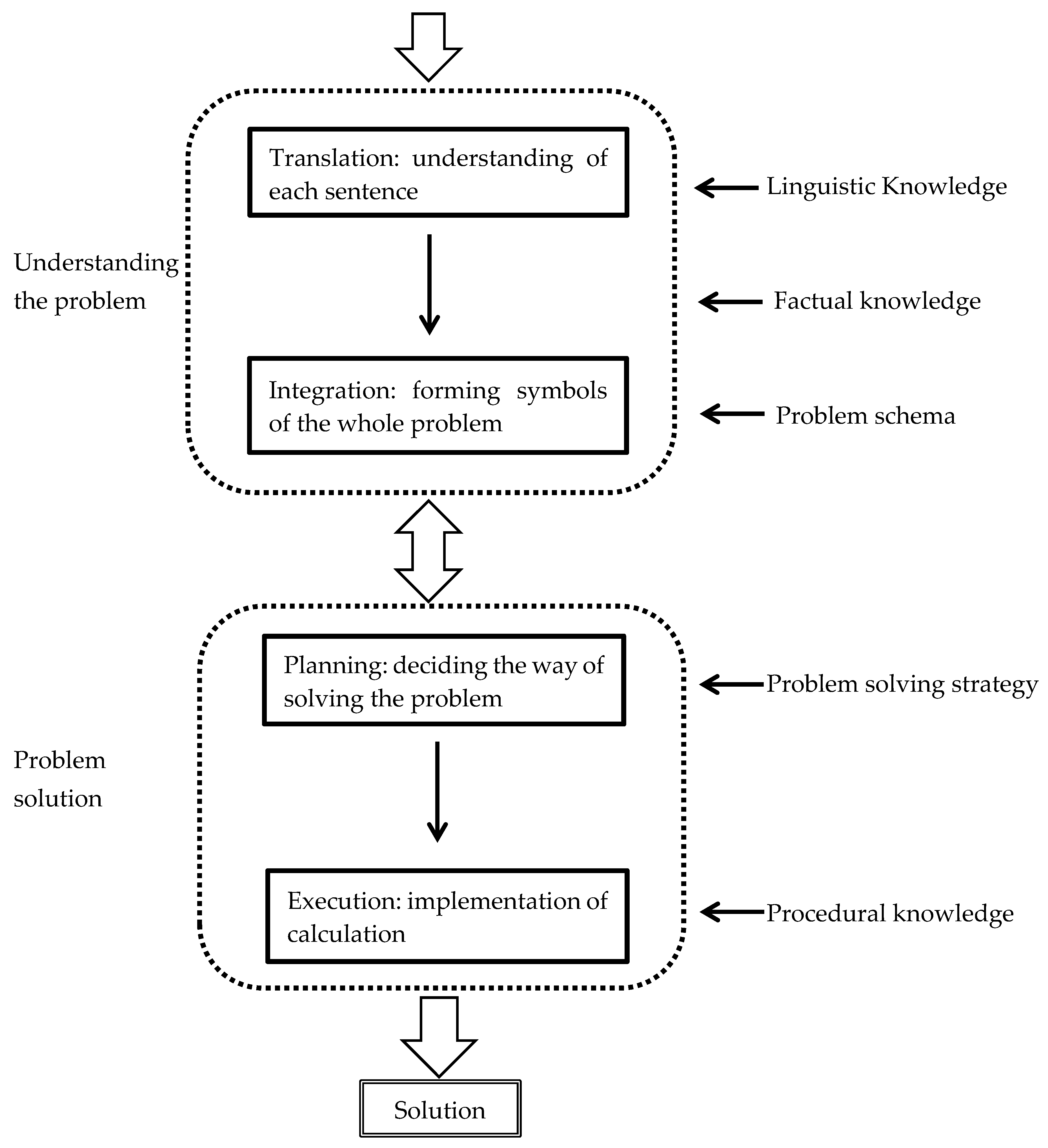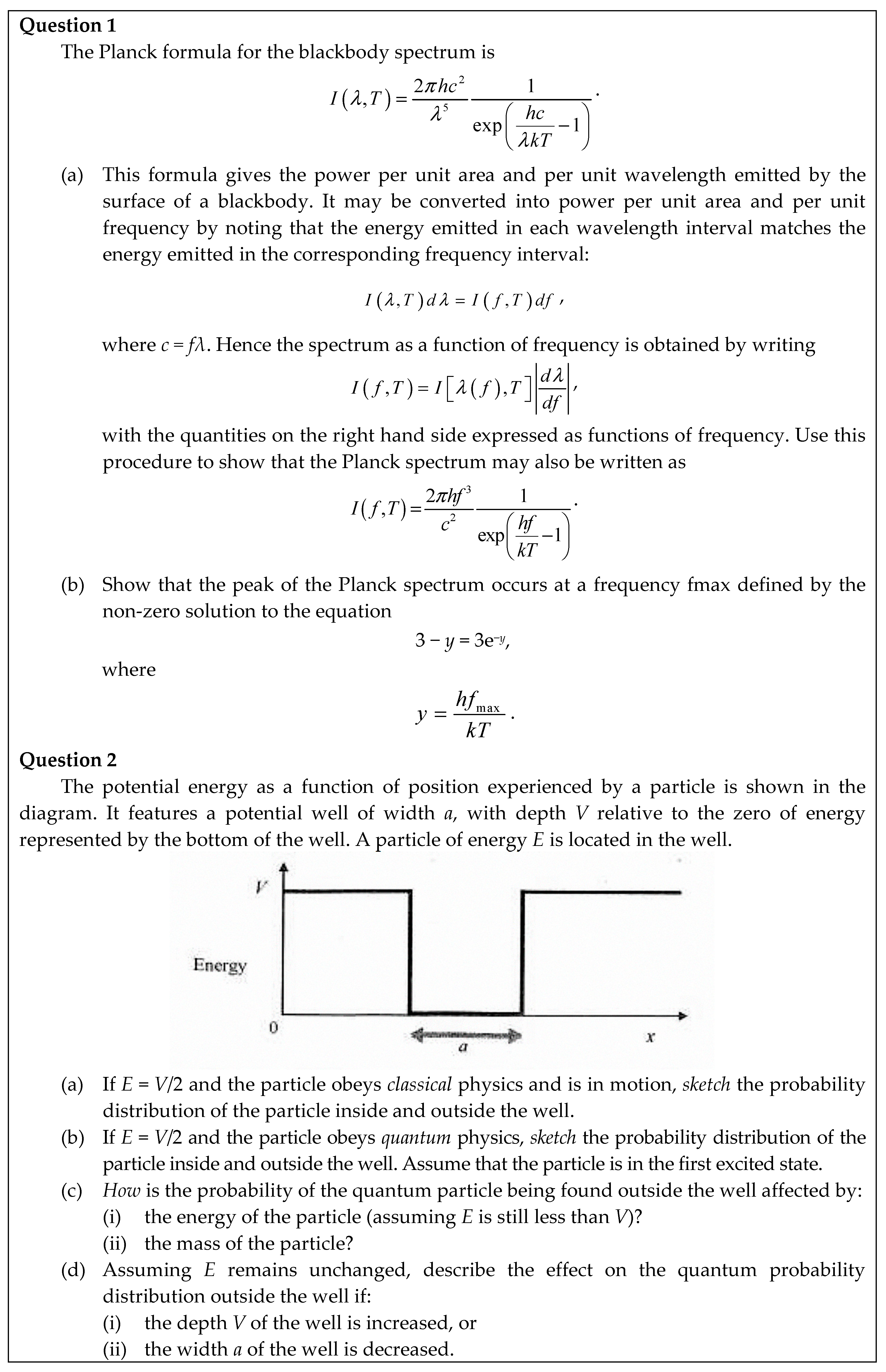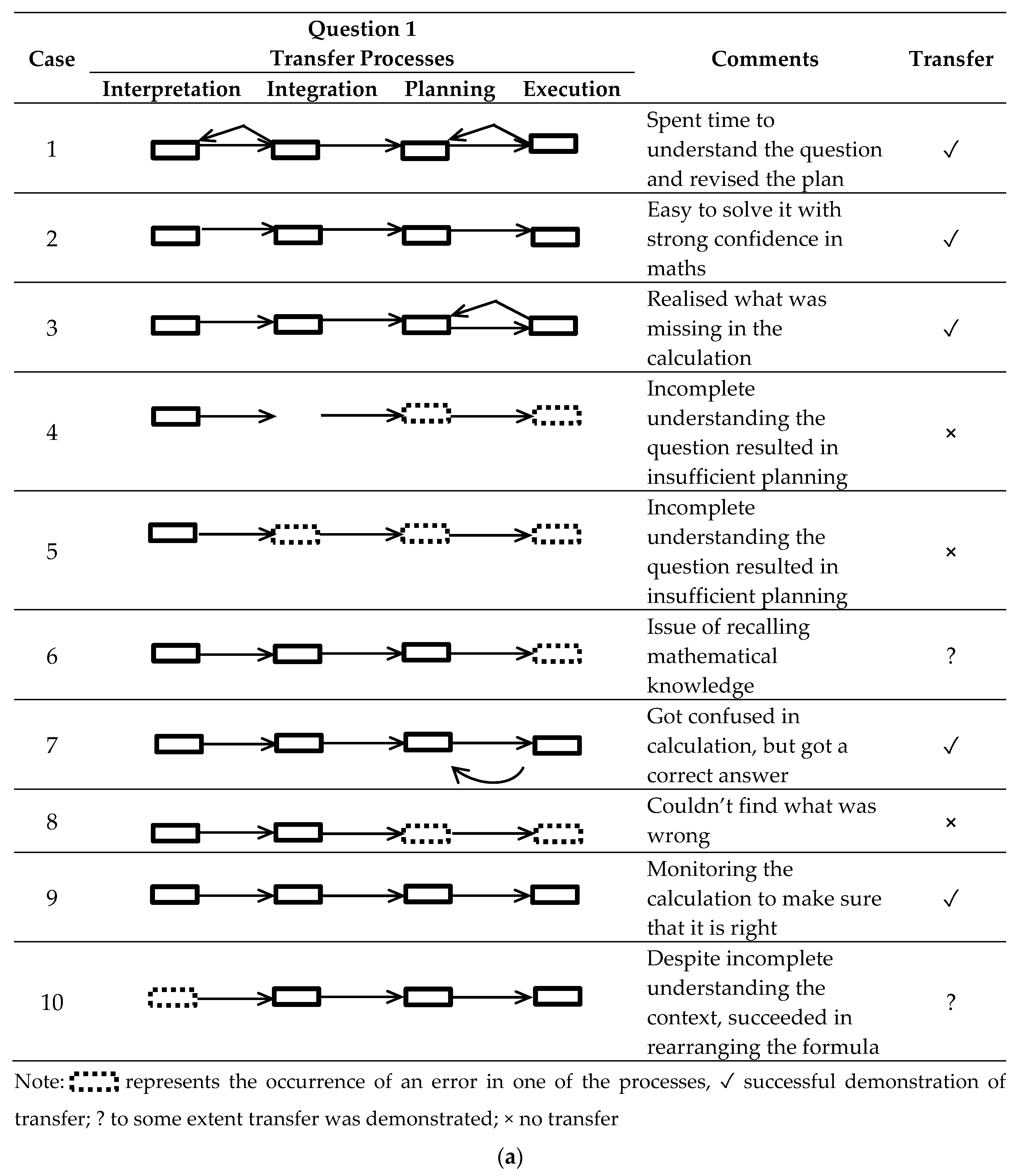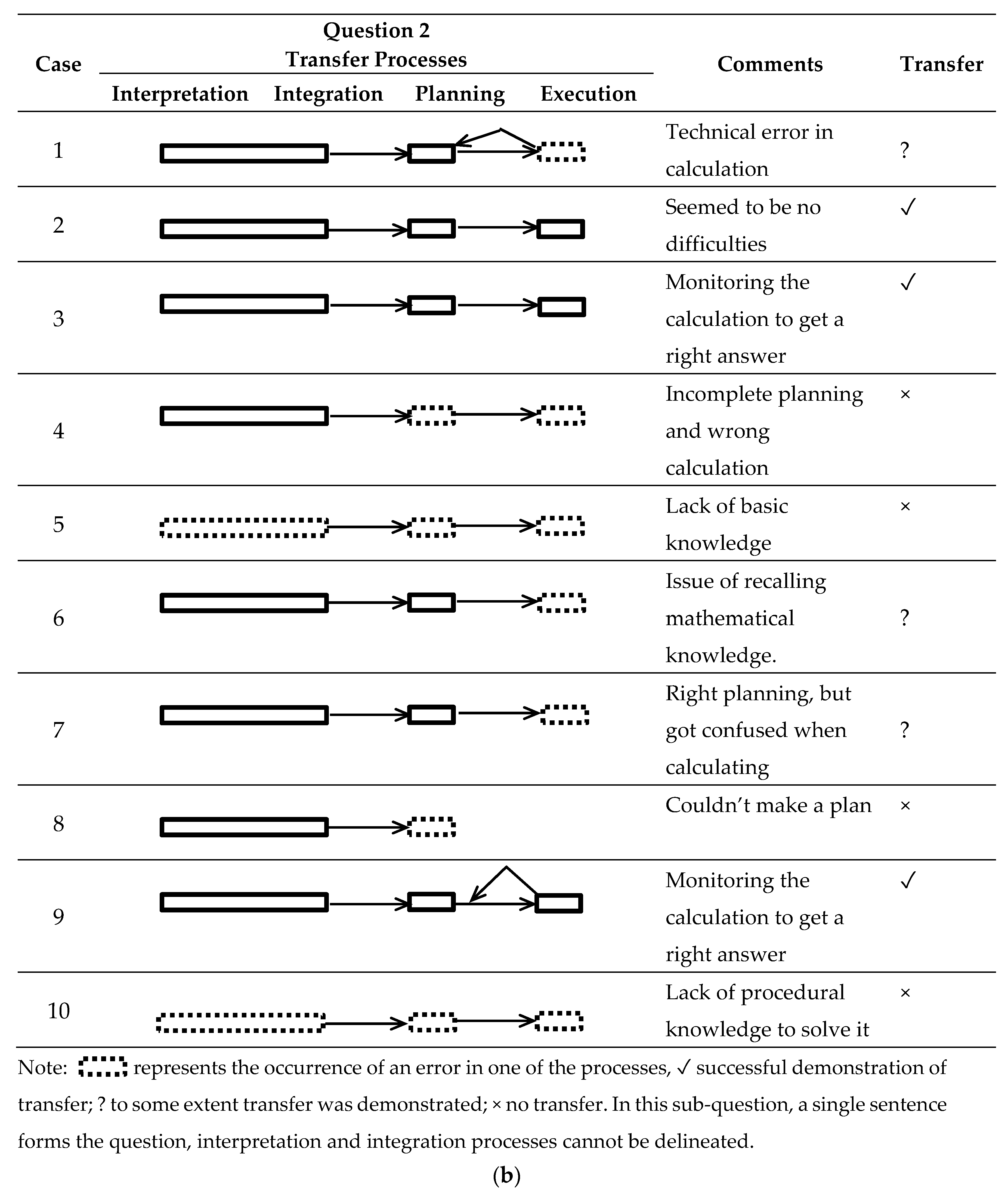Interdisciplinary Learning in Mathematics and Science: Transfer of Learning for 21st Century Problem Solving at University
Abstract
1. Introduction
1.1. Transfer and 21st Century Learning
1.2. The Relationship between Mathematics and Science
1.3. University Mathematics Service Courses and Science Courses
- What are the processes of transfer (if any) evident in students’ “think-aloud” accounts while solving physics exam questions requiring knowledge and understanding from their mathematics service courses?
- What are the challenges in transfer of learning reported by students and by academics?
- What teaching and learning factors do students and academics believe to enhance transfer?
2. Literature Review
2.1. Transfer of Learning
Students must apply the skills and knowledge they gain in one discipline to another and what they learn in school to other areas of their lives. A common theme is that ordinary instruction doesn’t prepare learners well to transfer what they learn, but explicit attention to the challenges of transfer can cultivate it.
2.2. Cognitive Explanations of Transfer
2.2.1. Higher Order Thinking and Bloom’s Taxonomy
2.2.2. Mathematical Problem-Solving Theories and Transfer
2.3. Socio-Cultural Explanations of Transfer
3. Methods
3.1. Research Design
3.2. Student Think-Aloud Study
3.2.1. Sample
3.2.2. Data Collection
3.2.3. Think-Aloud Tasks
3.2.4. Data Analysis
3.3. Interviews with Academics
3.3.1. Sample
3.3.2. Data Collection and Analysis Methods
4. Results and Discussion
4.1. Research Question 1: What Are the Processes of Transfer (If Any) Evident in Students “Think-Aloud” Accounts While Solving Physics Exam Questions Requiring Knowledge and Understanding from Their Mathematics Service Courses?
“in the first question with the Planck’s formula, it’s difficult to understand the question to begin with. So reading through the question is a lot to figure out. And you also have to recognise lots of different symbols, maths symbols which I’m sure if I didn’t know what they were I would be very lost, even more than I was.”
4.2. Research Question 2: What Are the Challenges in Transfer of Learning Reported by Students and by Academics?
4.3. Research Question 3: What Teaching and Learning Factors Do Students and Academics Believe to Enhance Transfer?
5. Conclusions
Author Contributions
Funding
Conflicts of Interest
References
- Ali, Marlina, Johari Surif, Abdul Halim Abdullah, Nor Hasniza Ibrahim, Corrienna Abdul Talib, Nurbiha A. Shukor, Noor Dayana Abd Halim, Dayana Farzeeha Ali, and Nornazira Suhairom. 2018. The Pattern of Physics Problem Solving between More Successful and Less Successful from Metacognitive Perspective. Advanced Science Letters 24: 8476–79. [Google Scholar] [CrossRef]
- Ananiadou, Katerina, and Magdalean Claro. 2009. 21st Century Skills and Competences for New Millennium Learners in OECD Countries. OECD Education Working Papers, No. 41. Paris: OECD Publishing. [Google Scholar] [CrossRef]
- Anderson, Lorin W. 2002. This issue. Theory into Practice 41: 210–11. [Google Scholar] [CrossRef]
- Anderson, Lorin W., David R. Krathwohl, and Benjamin Samuel Bloom. 2001. A Taxonomy for Learning, Teaching and Assessing: A Revision of Bloom’s Taxonomy of Educational Objectives, Complete ed. New York: Longman. [Google Scholar]
- Anderson, Winston A., Utpal Banerjee, Catherine L. Drennan, S. C. R. Elgin, I. R. Epstein, J. Handelsman, F. Hatfull, R. Losick, D. K. O’Dowd, B. M. Olivera, and et al. 2011. Changing the culture of science education at research universities. Science 331: 152–53. [Google Scholar] [CrossRef]
- Anwar, R. B., P. Purwanto, A. R. As’ari, S. Sisworo, and D. Rahmawati. 2018. The process of schematic representation in mathematical problem solving. Journal of Physics: Conference Series 1157: 1–5. [Google Scholar] [CrossRef]
- Australian Industry Group. 2013. Lifting Our Science, Technology, Engineering and Maths (STEM) Skills. Available online: https://www.voced.edu.au/content/ngv%3A56724 (accessed on 17 August 2020).
- Bannert, Maria, and Christoph Mengelkamp. 2008. Assessment of metacognitive skills by means of instruction to think-aloud and reflect when prompted. Does the varbalisation method affect learning? Metacognition Learning 3: 39–58. [Google Scholar] [CrossRef]
- Barnett, Susan M., and Stephen J. Ceci. 2002. When and where do we apply what we learn? A taxonomy for far transfer. Psychological Bulletin 128: 612–37. [Google Scholar] [CrossRef]
- Billing, David. 2007. Teaching for transfer of core/key skills in higher education: Cognitive skills. Higher Education 53: 483–516. [Google Scholar] [CrossRef]
- Bloom, Benjamin S., Max D. Engelhart, Edward J. Furst, Walker H. Hill, and David R. Krathwohl. 1956. Taxonomy of Educational Objectives: The Classification of Educational Goals: Handbook I: Cognitive Domain. New York: Longmans, Green and Co. [Google Scholar]
- Blumberg, Phyllis, Alison M. Mostrom, Barbara Bendl, Amy Kimchuk, and Kevin P. Wolbach. 2005. A model for integration of content, concepts, and context within separate courses: Making explicit the connections among disciplines. Problems, Resources, and Issues in Mathematics Undergraduate Studies 15: 59–80. [Google Scholar] [CrossRef]
- Bransford, John D., Ann L. Brown, and Rodney R. Cocking, eds. 1999. How People Learn: Brain, Mind, Experience, and School. Washington, DC: National Academy Press. [Google Scholar]
- Braun, Virginia, and Victoria Clarke. 2006. Using thematic analysis in psychology. Qualitative Research in Psychology 3: 77–101. [Google Scholar] [CrossRef]
- Brennan, Martha K., Ann M. Rule, Angela L. E. Walmsley, and Joy R. Swanson. 2010. A description of fourth grade children’s problem-solving in mathematics. Investigations in Mathematics Learning 2: 33–50. [Google Scholar] [CrossRef]
- Brown, John Seely, and Richard R. Burton. 1978. Diagnostic models for procedural bugs in basic mathematical skills. Cognitive Science 2: 155–62. [Google Scholar] [CrossRef]
- Brown, Ann L., and Mary Jo Kane. 1988. Preschool children can learn transfer: Learning to learn and learning from example. Cognitive Psychology 20: 493–523. [Google Scholar] [CrossRef]
- Chi, Michelene T. H., Miriam Bassok, Matthew W. Lewis, Peter Reimann, and Robert Glaser. 1989. Self-explanations: How students study and use examples in learning to solve problems. Cognitive Science 13: 145–82. [Google Scholar] [CrossRef]
- Chi, Michelene TH, James D. Slotta, and Nicholas De Leeuw. 1994. From things to processes: A theory of conceptual change for learning science concepts. Learning and Instruction 4: 27–43. [Google Scholar] [CrossRef]
- Cromley, Jennifer G., Lindsey E. Snyder-Hogan, and Ulana A. Luciw-Dubas. 2010. Cognitive activities in complex science text and diagrams. Contemporary Educational Psychology 35: 59–74. [Google Scholar] [CrossRef]
- De Corte, Erik. 1995. Learning theory and instructional science. In Learning in Humans and Machines: Interdisciplinary Learning Science. Oxford: Elsevier Science Ltd., pp. 97–108. [Google Scholar]
- De Corte, Erik. 2003. Transfer as the productive use of acquired knowledge, skills and motivations. Current Directions in Psychological Science 12: 142–46. [Google Scholar] [CrossRef]
- Deary, Ian J., Steve Strand, Pauline Smith, and Cres Fernandes. 2007. Intelligence and educational achievement. Intelligence 35: 13–21. [Google Scholar] [CrossRef]
- De Bortoli, Lisa, and Greg Macaskill. 2014. Thinking It through: Australian Students’ Skills in Creative Problem Solving. Available online: http://research.acer.edu.au/cgi/viewcontent.cgi?article=1018&context=ozpisa (accessed on 18 August 2020).
- Decker, Scott L., and Alycia M. Roberts. 2015. Specific cognitive predictors of early math problem solving. Psychology in the Schools 52: 477–88. [Google Scholar] [CrossRef]
- Detterman, Douglas K., and Robert J. Sternberg. 1993. The case for the prosecution: Transfer as an epiphenomenon. In Transfer on Trial: Intelligence, Cognition, and Instruction. Norwood: Ablex Publishing Corporartion, pp. 1–24. [Google Scholar]
- Engle, Randi A. 2012. The resurgence of research into transfer: An introduction to the final articles of transfer strand. Journal of the Learning Sciences 21: 347–52. [Google Scholar] [CrossRef]
- Evans, J. E. F. F. 1998. Problems of transfer of classroom mathematical knowledge to practical situations. In The Culture of the Mathematics Classroom. Edited by Falk Seeger, Joerg Voigt and Ute Washescio. Cambridge: Cambridge University Press, pp. 269–89. [Google Scholar]
- Gierl, Mark J. 1997. Comparing cognitive representations of test developers and students on a mathematics test with Bloom’s taxonomy. Journal of Educational Research 91: 26–32. [Google Scholar] [CrossRef]
- Greeno, James G. 2011. A situative perspective on cognition and learning in interaction. In Theories of Learning and Studies of Instructional Practice. New York: Springer, pp. 41–71. [Google Scholar]
- Greeno, James G., Joyce L. Moore, and David R. Smith. 1993. Transfer of situated learning. In Transfer on Trial: Intelligence, Cognition, and Instruction. Norwood: Ablex Publishing Corporation, pp. 99–167. [Google Scholar]
- Hatano, Giyoo, and James G. Greeno. 1999. Commentary: Alternative perspectives on transfer and transfer studies. International Journal of Educational Research 31: 645–54. [Google Scholar]
- Hattie, John. 2009. Visible Leaning: A Synthesis of over 800 Meta-Analyses Relating to Achievement. London: Routledge. [Google Scholar]
- Ichikawa, S., T. Haebara, T. Sugisawa, M. Seo, S. Kiyokawa, M. Inuzuka, K. Murayama, Y. Uesaka, H. Kobayashi, and K. Shinogaya. 2009. Development of COMPASS: Componential assessment for basic competence and study skills in mathematics. Cognitive Studies 16: 333–47. [Google Scholar]
- Karakok, Gulden. 2009. Students’ Transfer of Learning of Eigenvalues and Eigenvectors: Implementation of Actor-Oriented Transfer Framework. Ann Arbor: ProQuest LLC. [Google Scholar]
- Ke, Fengfeng. 2008. A case study of computer gaming for math: Engaged learning from gameplay? Computers & Education 51: 1609–20. [Google Scholar] [CrossRef]
- King, Gary, and Maya Sen. 2013. How Social Science Research Can Improve Teaching. PS: Political Science & Politics 46: 621–29. [Google Scholar]
- King, Deborah, and Joann Cattlin. 2015. The impact of assumed knowledge entry standards on undergraduate mathematics teaching in Australia. International Journal of Innovation in Science and Mathematics Education 46: 1032–45. [Google Scholar] [CrossRef]
- Kintsch, Walter. 1986. Learning from text. Cognition and Instruction 3: 87–108. [Google Scholar] [CrossRef]
- Krathwohl, David R. 2002. A revision of Bloom’s taxonomy: An overview. Theory into Practice 41: 212–18. [Google Scholar] [CrossRef]
- Krathwohl, David R., Benjamin S. Bloom, and Bertram B. Masia. 1964. Taxonomy of Educational Objectives: The Classification of Educational Goals, Handbook II: Affective Domain. New York: Longmans, Green and Co. [Google Scholar]
- Kropp, Russell Paul, Howard W. Stoker, and W. Louis Bashaw. 1966. The Construction and Validation of Tests of the Cognitive Processes as Described in the Taxonomy of Educational Objectives. Tallahassee: Institute of Human Learning and Department of Educational Research and Testing, Florida State University. [Google Scholar]
- Lave, Jean. 1988. Cognition in Practice: Mind, Mathematics and Culture in Everyday Life. Cambridge: Cambridge University Press. [Google Scholar]
- Lave, Jean, and Etienne Wenger. 1991. Situated Learning: Legitimate Peripheral Participation. Cambridge: Cambridge University Press. [Google Scholar]
- Lobato, Joanne. 2006. Alternative perspectives on the transfer of learning: History, issues, and challenges for future research. Journal of the Learning Sciences 15: 431–49. [Google Scholar] [CrossRef]
- Lobato, Joanne. 2008a. Research methods for alternative approaches to transfer: Implications for design experiments. In Handbook of Design Research in Education: Innovations in Science, Technology, Engineering, and Mathematics Learning and Teaching. Edited by Anthony E. Kelly, Richard A. Lesh and John Y. Baek. New York and London: Routledge, pp. 167–94. [Google Scholar]
- Lobato, Joanne. 2008b. When students don’t apply the knowledge you think they have, rethink your assumptions about transfer. In Making the Connection: Research and Teaching in Undergraduate Mathematics Education. Edited by Marilyn P. Carlson and Chris Rasmussen. Washington, DC: Mathematical Association of America, pp. 289–304. [Google Scholar]
- Lohman, David F. 2000. Complex information processing and intelligence. In Handbook of Intelligence. Edited by R. J. Sternberg. Cambridge: Cambridge University Press, pp. 285–340. [Google Scholar] [CrossRef]
- Malmberg, Lars-Erik, Theodore A. Walls, Andrew J. Martin, Todd D. Little, and Wee HT Lim. 2013. Primary school students’ learning experiences of, and self-beliefs about competence, effort, and difficulty: Random effects models. Learning and Individual Differences: Journal of Psychology and Education 28: 54–65. [Google Scholar] [CrossRef]
- Martin, Andrew J., Rachel Wilson, Gregory Arief D. Liem, and Paul Ginns. 2013. Academic momentum at university/college: Exploring the roles of prior learning, life experience, and ongoing performance in academic achievement across time. Journal of Higher Education 84: 640–74. [Google Scholar] [CrossRef]
- Marton, Ference. 2006. Sameness and difference in transfer. Journal of the Learning Sciences 15: 499–535. [Google Scholar] [CrossRef]
- Mayer, Richard E. 1992. Thinking, Problem Solving, and Cognition. New York: Freeman. [Google Scholar]
- Mayer, Richard E., and Merlin C. Wittrock. 1996. Problem-solving transfer. In Handbook of Educational Psychology. Edited by David C. Berliner and Robert C. Calfee. New York: Simon & Schuster Macmillan, pp. 47–62. [Google Scholar]
- Meichenbaum, Donald. 1980. A cognitive-behavioral perspective on intelligence. Intelligence 4: 271–83. [Google Scholar] [CrossRef]
- Mestre, Jose. 2003. Transfer of Learning: Issues and Research Agenda: Report of a Workshop Held at the National Science Foundation. Available online: http://www.nsf.gov/pubs/2003/nsf03212/start.htm (accessed on 18 August 2020).
- Miller, William G., Jack Snowman, and Takeshi O’Hara. 1979. Application of alternative statistical techniques to examine the hierarchal ordering in Bloom’s taxonomy. American Educational Research Journal 16: 241–48. [Google Scholar] [CrossRef]
- Monaghan, Frank. 2005. ‘Don’t think in your head, think-aloud’: ICT and exploratory talk in the primary school mathematics classroom. Research in Mathematics Education 7: 83–100. [Google Scholar] [CrossRef][Green Version]
- Nakakoji, Yoshitaka, Rachel Wilson, and Leon Poladian. 2014. Maths is a strong predictor of STEM attainment in first year university. Paper presented at The Australian Conference on Science and Mathematics Education (Formerly UniServe Science Conference), Sydney, Australia, September 29–October 1. [Google Scholar]
- Nakakoji, Yoshitaka, Rachel Wilson, and Leon Poladian. 2014. Mixed methods research on the nexus between mathematics and science. International Journal of Innovation in Science and Mathematics Education 22: 61–76. [Google Scholar]
- Nakakoji, Yoshitaka, and Rachel Wilson. 2018. First-Year mathematics and its application to science: Evidence of transfer of learning to Physics and Engineering. Education Sciences 8: 8. [Google Scholar] [CrossRef]
- National Research Council. 2013. The Mathematical Sciences in 2025. Washington, DC: National Academies Press. [Google Scholar]
- Nisbett, Richard E., Joshua Aronson, Clancy Blair, William Dickens, James Flynn, Diane F. Halpern, and Eric Turkheimer. 2012. Intelligence: New findings and theoretical developments. American Psychologist 67: 130–59. [Google Scholar] [CrossRef]
- OECD. 2018. Future of Education and Skills 2030: Conceptual Learning Framework. A Literature Summary for Research on the Transfer of Learning. Paris: OECD Conference Centre. [Google Scholar]
- Office of the Chief Scientist. 2013. Science, Technology, Engineering and Mathematics in the National Interest: A Strategic Approach. Available online: http://www.chiefscientist.gov.au/2012/05/mes-report/ (accessed on 18 August 2020).
- Okamoto, Masashi. 2008. Suugakuteki mondaikaiketu-ni okeru metaninchi [Metacognition on mathematical problem solving]. In Metaninchi: Gakushu-Wo Sasaeru Koujigen-Ninchikinou [Metacognition: The higher Order Cognitive Functions Supporting the Ability of Learning]. Edited by M. Sannomiya. Kyoto: Kitaoji Shobo, pp. 111–29. [Google Scholar]
- Orton, Tony, and Tom Roper. 2000. Science and mathematics: A relationship in need of counselling? Studies in Science Education 35: 123–53. [Google Scholar] [CrossRef]
- Owen, Elizabeth, and John Sweller. 1985. What do students learn while solving mathematics problems? Journal of Educational Psychology 77: 272–84. [Google Scholar] [CrossRef]
- Petocz, Peter, Sue Gordon, and Anna Reid. 2006. Recognising and Developing Good Statistics Teachers. Paper presented at the Seventh International Conference on Teaching Statistics, ICOTS7, Salvador, Brazil; Available online: https://www.stat.auckland.ac.nz/~iase/publications/17/5B2_PETO.pdf (accessed on 18 August 2020).
- Reed, Stephen K. 1993. A schema-based theory of transfer. In Transfer on Trial: Intelligence, Cognition, and Instruction. Edited by Douglas K. Detterman and Robert J. Sternberg. Norwood: Ablex Publishing Corporation, pp. 39–67. [Google Scholar]
- Richmond, Lauren L., Alexandra B. Morrison, Jason M. Chein, and Ingrid R. Olson. 2011. Working memory training and transfer in older adults. Psychology and Aging 26: 813–22. [Google Scholar] [CrossRef]
- Rindermann, Heiner. 2007. The g-factor of international cognitive ability comparisons: The homogeneity of results in PISA, TIMSS, PIRLS, and IQ-tests across nations. European Journal of Personality 21: 667–706. [Google Scholar] [CrossRef]
- Roberts, A. L., M. D. Sharma, S. Britton, and P. B. New. 2007. An index to measure the ability of first year science students to transfer mathematics. International Journal of Mathematical Education in Science and Technology 38: 429–48. [Google Scholar] [CrossRef]
- Royer, James M. 1979. Theories of the transfer of learning. Educational Psychologist 14: 53–69. [Google Scholar] [CrossRef]
- Saavedra, Anna Rosefsky, and V. Darleen Opfer. 2012. Learning 21st-century skills requires 21st-century teaching. Phi Delta Kappan 94: 8–13. [Google Scholar] [CrossRef]
- Sadler, Philip M., and Robert H. Tai. 2007. The two high-school pillars supporting college science. Science 317: 457–58. [Google Scholar] [CrossRef]
- Salomon, Gavriel, and David N. Perkins. 1989. Rocky roads to transfer: Rethinking mechanisms of a neglected phenomenon. Educational Psychologist 24: 113–42. [Google Scholar] [CrossRef]
- Seaman, Mark. 2011. Bloom’s taxonomy: Its evolution, revision, and use in the field of education. Curriculum and Teaching Dialogue 13: 29–43. [Google Scholar]
- Seo, M. 2010. Suugakuteki mondaikaiketu to sono kyouiku [Mathematical problem solving and its education]. In Theories and Applications of Cognitive Psychology 5: Development and Learning. Edited by S. Ichikawa. Kyoto: Kitaoji Shobo, pp. 227–51. [Google Scholar]
- Siddiq, Fazilat, and Ronny Scherer. 2017. Revealing the processes of students’ interaction with a novel collaborative problem solving task: An in-depth analysis of think-aloud protocols. Computer in Human Behavior 76: 509–25. [Google Scholar] [CrossRef]
- Siler, Stephanie, and Kevin Willow. 2014. Individual differences in the effect of relevant concreteness on learning and transfer of a mathematical concept. Learning and Instruction 33: 170–81. [Google Scholar] [CrossRef]
- Silver, Edward A. 1987. Foundations of cognitive theory and research for mathematics problem-solving instruction. In Cognitive Science and Mathematics Education. Edited by Alan H. Schoenfeld. Hillsdale: Lawrence Erlbaum Associates, pp. 33–60. [Google Scholar]
- Stage, Elizabeth K., Harold Asturias, Tina Cheuk, Phil A. Daro, and Sally B. Hampton. 2013. Opportunities and challenges in next generation standards. Science 340: 276–77. [Google Scholar] [CrossRef] [PubMed]
- Sternberg, Robert J., ed. 2000. Handbook of Intelligence, 1st ed. Cambridge: Cambridge University Press. [Google Scholar]
- Suzuki, Kyoko. 1997. Cognitive constructs measured in word problems: A comparison of students’ responses in performance-based tasks and multiple-choice tasks for reasoning. Paper presented at the Annual Meeting of the American Educational Research Association, Chicago, IL, USA, March 24. [Google Scholar]
- Tariq, Vicki N. 2013. Quantitative skills in science. International Journal of Mathematical Education in Science and Technology 44: 779–81. [Google Scholar] [CrossRef]
- Taub, Gordon E., Timothy Z. Keith, Randy G. Floyd, and Kevin S. McGrew. 2008. Effects of general and broad cognitive abilities on mathematics achievement. School Psychology Quarterly 23: 187–98. [Google Scholar] [CrossRef]
- The Royal Society. 2014. Vision for Science and Mathematics Education. Available online: https://royalsociety.org/education/policy/vision/ (accessed on 18 August 2020).
- The Royal Society Science Policy Centre. 2014. Vision for Science and Mathematics Education. Available online: https://royalsociety.org/topics-policy/projects/vision/ (accessed on 18 August 2020).
- Thompson, Tony. 2008. Mathematics teachers’ interpretation of higher–order thinking in Bloom’s taxonomy. International Electronic Journal of Mathematics Education 3: 96–109. [Google Scholar]
- Thorndyke, Perry W. 1984. Applications of schema theory in cognitive research. In Tutorials in Learning and Memory. Edited by John Robert Anderson and Stephen Michael Kosslyn. San Francisco: Freeman, pp. 167–91. [Google Scholar]
- U.S. Congress Joint Economic Committee. 2012. STEM Education: Preparing for the Jobs of the Future. Available online: https://www.jec.senate.gov/public/index.cfm/democrats/2012/4/stem-educationpreparing-jobs-of-the-future (accessed on 18 August 2020).
- U.S. Department of Education. 2016. STEM 2026: A Vision for Innovation in STEM Education. Available online: https://innovation.ed.gov/files/2016/09/AIR-STEM2026_Report_2016.pdf (accessed on 18 August 2020).
- Van Someren, Maarten W., Yvonne F. Barnard, and Jacobijn A. C. Sandberg. 1994. The Think-aloud Method: A Practical Guide to Modelling Cognitive Processes. London: Academic Press. [Google Scholar]
- Young, Kirsty A. 2005. Direct from the source: The value of ‘think-aloud’ data in understanding learning. Journal of Educational Enquiry 6: 19–33. [Google Scholar]




| Classification | Explanation | Examples |
|---|---|---|
| 1. Knowledge (i) Knowledge of specifics (ii) Knowledge of ways and means of dealing with specifics (iii) Knowledge of the universals and abstractions in a field | Knowledge contains behaviours and tests situations which emphasize the remembering, either by recognition or recall, of ideas, material, or phenomena (p. 62). | (i) To define technical terms in mathematics by giving their attributes, properties, or relations. (ii) Knowledge of the mathematical techniques and methods used by scientists in seeking to answer questions about the world. (iii) The recall of major theorems in mathematics (pp. 64–77). |
| 2. Comprehension (i) Translation (ii) Interpretation (iii)Extrapolation | The emphasis is on the grasp of the meaning and intent of the material (p. 144). | (i) The ability to translate abstract concepts in mathematics by giving an illustration or example. (ii) The ability to interpret various types of numerical data. (iii) Skill in predicting continuation of trends using mathematical models. (pp. 92–96). |
| 3. Application | Remembering and bringing to bear upon given material the appropriate generalizations or principles (p. 144) | (i) The ability to apply scientific principles, postulates, theorems in mathematics, or other abstractions to new situations (ii) The ability to apply the laws of trigonometry to practical situations |
| 4. Analysis (i) Analysis of elements (ii) Analysis of relationships (iii) Analysis of organizational principles | Emphasizes the breakdown of the material into its constituent parts and detection of the relationships of the parts and of the way they are organized. (p. 144) | (i) Ability to distinguish a conclusion from statements which support it. (ii) Ability to detect logical fallacies in arguments and proof in mathematics. (iii) Ability to recognize form and pattern in mathematics as a means of understanding their meaning (pp. 146–48) |
| 5. Synthesis (i) Production of a unique communication (ii) Production of a plan, or proposed set of operations (iii) Derivation of a set of abstract relations | Definition: the putting together of elements and parts so as to form a whole. In comparison with the subordinate classifications, this classification is less practical and more emphasis on uniqueness and originality. (p. 162) | (i) Skill in writing, using an excellent organization of ideas and statements in mathematics. (ii) Ability to integrate the results of an investigation into an effective plan or solution to solve a problem in mathematics. (iii) Ability to make mathematical discoveries and generalizations. (pp. 169–72) |
| 6. Evaluation (i) Judgments in terms of internal evidence (ii) Judgments in terms of external evidence | Definition: the making of judgments about the value, for some purpose, of ideas, works, solutions, methods, material, etc. In addition, the process may require behavior classified in other subordinate categories (p. 185) | (i) Judging internal standards, the ability to assess the quality of quantitative data analysis in relation to the experiments conducted. (ii) The comparison of major theories, generalizations and facts in mathematics and science. (Based on pp. 189, 192) |
| Processes | Words or Phrases | Mathematical Expression |
|---|---|---|
| I know the meaning of I’m not sure about | c = fλ y = exp (−kx), where k > 0 |
| This question means I can’t understand the question. | Requires rearrangement of I (f, T) Understanding of a graph of y = exp (−kx), k = (√2m (V−E))/ℏ |
| I know how to do Show No idea about | ∂I/∂f = 0 at f = fmax Preparation of drawing the graph with considering how it changes with respect to m, V, and E. |
| Substitution of into (Partial) derivative of | λ = c/f, dλ/df = −c/f2 Actual sketch of the graph |
| Factors Enhance Transfer | Factors Hinder Transfer | |
|---|---|---|
| Academics’ perspective | Interdisciplinary learning Showing relevance of maths Practice Confidence & self-belief Prior leaning | Anxiety Poor feedback Poor explanation Translation Disparity of pedagogy Mismatch of expectation Surface learning approaches Poor maths preparedness |
| Students’ perspective | Importance of understanding the question Memory or recall Prior learning Intuition | Anxiety Mismatch of expectation Difficulty in understanding the problem Difficulty in recalling maths knowledge & skills |
© 2020 by the authors. Licensee MDPI, Basel, Switzerland. This article is an open access article distributed under the terms and conditions of the Creative Commons Attribution (CC BY) license (http://creativecommons.org/licenses/by/4.0/).
Share and Cite
Nakakoji, Y.; Wilson, R. Interdisciplinary Learning in Mathematics and Science: Transfer of Learning for 21st Century Problem Solving at University. J. Intell. 2020, 8, 32. https://doi.org/10.3390/jintelligence8030032
Nakakoji Y, Wilson R. Interdisciplinary Learning in Mathematics and Science: Transfer of Learning for 21st Century Problem Solving at University. Journal of Intelligence. 2020; 8(3):32. https://doi.org/10.3390/jintelligence8030032
Chicago/Turabian StyleNakakoji, Yoshitaka, and Rachel Wilson. 2020. "Interdisciplinary Learning in Mathematics and Science: Transfer of Learning for 21st Century Problem Solving at University" Journal of Intelligence 8, no. 3: 32. https://doi.org/10.3390/jintelligence8030032
APA StyleNakakoji, Y., & Wilson, R. (2020). Interdisciplinary Learning in Mathematics and Science: Transfer of Learning for 21st Century Problem Solving at University. Journal of Intelligence, 8(3), 32. https://doi.org/10.3390/jintelligence8030032





